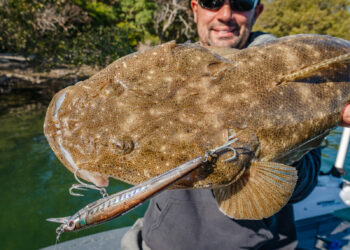
BIGEYE Trevally (Caranx sexfasciatus) are one of the more easily recognised species of the internationally renowned sportfish in the trevally family (Carangidae). This is partly due to them being one of the larger trevallies, but also because they are fairly common and easy to identify. As their name suggests, bigeye trevally have relatively large eyes (with the posterior portion of the eye being covered by a gelatinous eyelid), but they also have a rounder, more dorsally compressed body plan compared to most other trevallies, as well as distinctive white tips to the dorsal and anal fins. However, their body colour can vary markedly depending on the environment in which they are encountered. In clear water over tropical reef flats, C. sexfasciatus are usually silver/chrome with a dark eye, bright yellow tail and anal fin. In contrast, when encountered in the brackish upper reaches of tropical estuaries, the whole fish can be brassy brown to almost black.
This species is found throughout a large portion of the tropical Indo-Pacific region including the Indian Ocean, Red Sea, throughout Asia and the Pacific Ocean north to Japan, south to Australia and as far east as California, Mexico and the Galapagos Islands. In Australia, C. sexfasciatus can be encountered throughout our tropical estuaries and offshore reefs from north of Perth in WA throughout the top end, throughout Queensland down to the central NSW coast and seasonally as far south as Sydney during the summer months.
The life history of this species is typical of many other tropical sportfish, with juveniles frequenting estuarine nursery areas for the first few years of life before they mature and move to offshore reefs as adults. Indeed, schools of adult bigeye trevally are closely associated with coral reefs, where they can be often observed slowly milling around coral outcrops or other features near the surface or midwater to depths of nearly 100 meters for most of the day. However, once daylight begins to fade these large schools disperse as the fish depart at dusk for feeding forays that continue well into the night. It is well known that this species feeds most actively at night, particularly during dark moon phases.
Under these conditions, their relatively large eyes must provide them with an advantage over their prey species, allowing them to effectively detect and consume smaller pelagic fishes as well as squid, and crustaceans like shrimp and prawns in what appears to us to be complete darkness. Indeed, one of the most effective ways to catch these fish is to use small lures or jigs cast and steadily retrieved through the surface layers in the middle of the night.
Given the broad geographical range of this species, its relatively large size, and popularity as a food fish throughout much of Asia, surprisingly little is known regarding biological facts of importance to fisheries management. It is known that the maximum size of C. sexfasciatus is around 120 cm in total length, and they can reach up to 18kg, with the IGFA all tackle world record being a 14.3 kg specimen captured in the Seychelles in 1997. Growth rates are largely undocumented, but a few rare studies of very small numbers of bigeye trevally indicate that fish around 70 cm long may be over 10 years old. Regarding age at first maturity, it appears these fish are immature at 30 cm, but are mature by around 40cm long.




















